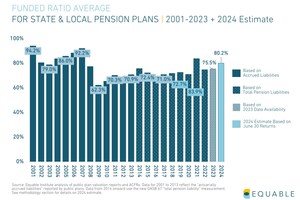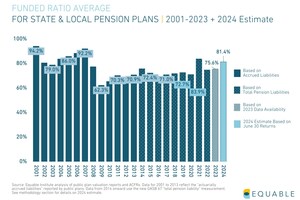NEW YORK, April 21, 2020 /PRNewswire/ -- A new report from Equable Institute examining the impact of growing teacher pension unfunded liabilities on state K-12 education budgets finds that the share of state education spending going to pension costs has nearly doubled from 7.5% in 2001 to 14.4% in 2018. The report is the first of its kind to quantify the effects of growing unfunded liabilities on the education system in detail.
The report, Hidden Education Funding Cuts, studies state-level K-12 education spending and teacher pension plan funding data to assess the repercussions of underfunded pensions on education budgets. The data reveals a pervasive phenomenon of pension debt crowding out available dollars for other vital education funding priorities. Nationally, teacher pension unfunded liabilities have exploded from $20 billion in 2001, to over $640 billion in 2018. Meanwhile, education budgets have remained stagnant, increasing only 26% when accounting for inflation in the same time period.
States' tolerance of these growing unfunded liabilities have resulted in a significant increase in employer contribution rates. The report finds that actuarially determined contributions (ADEC) for states and school districts have also more than doubled from 9.2% to 19.3% of teacher payroll since 2001. For greater context, in 2018, K–12 employers paid $19.6 billion in normal costs (i.e., for pension benefits earned that year), and $42.4 billion more to cover unfunded liability amortization payments. In 2001, contributions going toward unfunded liabilities were virtually zero.
There are direct implications for how these hidden education funding cuts are influencing resources available for teacher compensation, as well as for programs designed to ensure an equitable distribution of resources for low-income communities.
While the report finds that hidden education funding cuts as a result of pension costs are widespread, each state's specific challenge is unique.
"Hidden education funding cuts are a serious issue for nearly every state in the country, but local context always matters," notes Equable Institute's Executive Director, Anthony Randazzo. "And while this problem can't be solved with a one-size-fits-all approach, states should start by considering whether the use of education funds to pay down unfunded liabilities is an appropriate budgeting approach. Plus, working to ensure and solution holds teachers and students harmless would be critical for not exacerbating existing funding issues."
Hidden Education Funding Cuts is accompanied by a set of 51 state profiles (including the District of Columbia) that illustrates the scope and severity of hidden education funding cuts in each state. Additionally, a dedicated microsite illuminates the reports' findings with exclusive data visualization, additional analysis and resources.
Equable Institute used a rigorous methodology based on states' and pension plans' own reporting to accurately measure the share of education funding being diverted to pension costs. The report relies on information reported to the National Association of State Budget Officers (NASBO) to calculate states' own-source K-12 spending and uses funding data reported by each of the statewide retirement systems covering classroom teachers to calculate the state's pension spending. To keep state funding cut measurements consistent across the country, the report does not consider local dollars, federal education funding, or one-time general fund contributions to pension costs in its analysis.
To read and download the report and state profiles please visit: www.equable.org/hiddenfundingcuts
To access the Hidden Education Funding Cuts press kit click here.
Equable.org | Twitter: @EquableInst | Facebook: @EquableInstitute | Instagram: @EquableInst
About Equable Institute
Equable Institute is a nonprofit that educates and informs employees, retirees, labor, and taxpayers about how to create real retirement plan sustainability and affordability without sacrificing future income security. We are radically bipartisan, intensely analytical, and unapologetically direct. Equable exists to support public sector workers in understanding how their retirement systems can be improved, and to help state and local governments find ways to both fix threats to municipal finance stability and ensure the retirement security of all public servants.
SOURCE Equable Institute

Related Links
WANT YOUR COMPANY'S NEWS FEATURED ON PRNEWSWIRE.COM?
Newsrooms &
Influencers
Digital Media
Outlets
Journalists
Opted In






Share this article